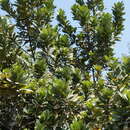Comprehensive Description
provided by Smithsonian Contributions to Botany
Lucuma obovata Humboldt, Bonpland & Kunth
Lucuma obovata Humboldt, Bonpland & Kunth, Nov. Gen. et Sp. 3:241. 1819.—Pancher in Cuzent, Iles Soc. Tahiti 234. 1860.—Lanessan, Pl. Ut. Col. Franc. 865. 1866.—Butteaud, Fl. Tahiti. 56. 1891 [now usually called Pouteria lucuma (Ruiz & Pavon) O. Kuntze].
DESCRIPTION (based on South American material).—Tree to 10 m tall, young growth brownish sericeous; leaves obovate, generally 10–25 × 4–9 cm, thick-chartaceous, apex obtuse to rounded, base contracted to a petiole 2–4 cm long, nerves 12–15 on a side, opposite to alternate, lightly pubescent to glabrous beneath; flowers 10–15 mm long, on stout, straight to somewhat recurved pedicels, 1–2 in an axil, 5–15 mm long, sepals 5, imbricate, somewhat unequal, rounded to oval, brownish sericeous tomentose, to 1 cm long, corolla cylindric, strongly exserted at anthesis, to 12–15 mm long, lobed ¼–⅓ the way, lobes rounded, imbricate, very finely sericeous or subglabrous, stamens 5, included, inserted on the corolla tube opposite lobes, filament short, swollen, anthers ovate, obtuse, basifixed, staminodia 5, subulate, opposite the sinuses, pistil with ovary 5-loculed, ovoid, hirsute in basal part, glabrous above, tapering to a stout, cylindrical style, stigma minute, terminal; fruit fleshy, depressed, globose with a slight umbo, with 1 or 2 seeds developed, these globose with an oblong ovate scar on the inner side, with 2 thick cotyledons.
RANGE.—Society Islands (cultivated): Tahiti: Introduced in 1850 by Bishop d'Axieri, according to Pancher. Not seen by us. [Native from Colombia to Peru; cultivated in tropical countries].
LOCAL NAMES.—English: lucuma. French: jaune d'oeuf.
- bibliographic citation
- Grant, Martin Lawrence, Fosberg, F. Raymond, and Smith, Howard M. 1974. "Partial Flora of the Society Islands: Ericaceae to Apocynaceae." Smithsonian Contributions to Botany. 1-85. https://doi.org/10.5479/si.0081024X.17

